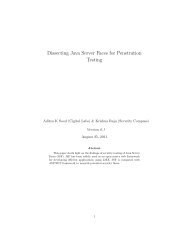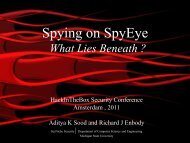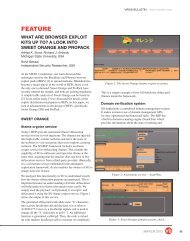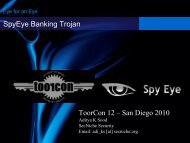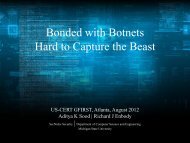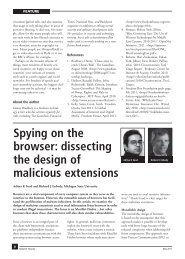browser exploit packs â exploitation tactics - SecNiche Security Labs
browser exploit packs â exploitation tactics - SecNiche Security Labs
browser exploit packs â exploitation tactics - SecNiche Security Labs
Create successful ePaper yourself
Turn your PDF publications into a flip-book with our unique Google optimized e-Paper software.
BROWSER EXPLOIT PACKS – EXPLOITATION TACTICS SOOD & ENBODY<br />
server. ionCube Ioncube first collects the PHP version information and<br />
uses specific DLLs in order to encode the BlackHole BEP PHP<br />
files appropriately. With the use of the ionCube encoder, it<br />
becomes really hard to analyse the BlackHole BEP.<br />
SNo<br />
BlackHole BEP files<br />
1 ioncube_loader_win_4.1.dll<br />
2 ioncube_loader_win_4.2.dll<br />
3 ioncube_loader_win_4.3.dll<br />
4 ioncube_loader_win_4.4.dll<br />
5 ioncube_loader_win_5.0.dll<br />
6 ioncube_loader_win_5.1.dll<br />
Table 1: ionCube DLL version specific to PHP version.<br />
Second, the BlackHole BEP also uses reverse encoding and<br />
concatenation in generating remote objects in VBScript. A<br />
code snippet present in Listing 3 shows that the BlackHole<br />
BEP applies extensive reverse calls in order to make the<br />
analysis somewhat harder.<br />
In Listing 3, the ‘:a’ parameter holds the value of the remote<br />
address of the domain hosting the BlackHole BEP. The<br />
StrReverse function is used to implement a normal trick in<br />
calling the code. When the code is rendered in the <strong>browser</strong>,<br />
‘tcejbOmetsySeliF.gnitpircS’ is treated as<br />
‘Scripting.FileSystemObject’ , ‘PTTHLMX.2LMXSM’ is<br />
treated as ‘MSXML2.XMLHTTP’ and ‘maertS.BDODA’ is<br />
treated as ADOBA.Stream. We decode the VBScript to get<br />
this code. However, unwrapping the encoding layers provides<br />
better insight into the working of malicious VBScript code.<br />
This script pushes the operating system to run wmplayer.exe<br />
and realplayer.exe by calling the ‘Script.Shell’ object.<br />
Exploit distribution and infections<br />
By performing continuous analysis and deobfuscation of<br />
sample code, we found that the BlackHole BEP serves a<br />
number of <strong>exploit</strong>s for specific CVEs as presented in Table 2.<br />
After carefully analysing the <strong>exploit</strong> list, we find that these<br />
<strong>exploit</strong>s are the most reliable ones and their ratio of<br />
successful execution is high. Further, the most used <strong>exploit</strong>s<br />
in the BlackHole BEP are CVE-2010-0840 [11] and<br />
CVE-2010-0842 [12]. These vulnerabilities have been found<br />
in the Java Open Business Engine (OBE) and Java workflow<br />
engine [13]. Since Java is platform independent, this flaw can<br />
be <strong>exploit</strong>ed easily on any type of <strong>browser</strong>. In general, a third<br />
part vulnerability (such as a Java plug-in) results in a<br />
compromise of all types of <strong>browser</strong>s running on different<br />
operating systems. As a result of this, the infection rate is<br />
quite high due to ease of <strong>exploit</strong>ing these Java vulnerabilities<br />
as presented in Figure 2.<br />
SNo Year Exploit – CVEs<br />
1 2010 CVE-2010-0188, CVE-2010-2884,<br />
CVE-2010-0842, CVE-2010-3552,<br />
CVE-2010-1297, CVE-2010-0840,<br />
CVE-2010-0806, CVE-2010-1885<br />
2 2009 CVE-2009-0927, CVE-2009-4324<br />
3 2008 CVE-2008-2992<br />
4 2006 CVE-2006-0003<br />
Table 2: Exploits served by the BlackHole BEP.<br />
The Java-OBE <strong>exploit</strong> discussed above is completely<br />
undetectable by anti-virus engines and executes in a stealthy<br />
manner. In other ways, BlackHole uses a standard<br />
cryptographic function in conjunction with other<br />
cryptographic algorithms in order to make code analysis<br />
harder, as well as making it hard to detect by anti-virus<br />
engines and tools like Wepawet. The BlackHole <strong>exploit</strong> pack<br />
also uses helper files that result in detection of the software<br />
version. The BlackHole BEP uses the ‘plugin_detect.js’ script<br />
to fingerprint the available plug-ins in the victim <strong>browser</strong>.<br />
Apart from this, we also find ‘JavaSignedApplet.jar’,<br />
‘SiteAudioHelper.jar’ and ‘JavaOBE.jar’ which support the<br />
execution of Java <strong>exploit</strong>s by collecting requisite information<br />
from the victim <strong>browser</strong>. These helper files also provide the<br />
default environment required for triggering vulnerabilities.<br />
Botnets collaboration<br />
Most BEPs work collectively with botnets to spread infections<br />
across the web. During our analysis, we found that the<br />
BlackHole BEP works effectively with the Zeus botnet, a<br />
third-generation banking malware. In this particular sample,<br />
Zeus works collaboratively with BlackHole, which shows that<br />
the BEP plays a critical role in determining the success of<br />
w=3000:x=200 :y=1 :z=false :a = “http://malicious.su/f0d/bl2.php?i=3”<br />
:Set e = Createobject(StrReverse(“tcejbOmetsySeliF.gnitpircS”))<br />
:b = e.GetSpecialFolder(2) & “\exe.exe”:OT = “GET”<br />
:Set c = CreateObject(StrReverse(“PTTHLMX.2LMXSM”))<br />
:Set d = CreateObject(StrReverse(“maertS.BDODA”))<br />
Set o=Createobject(StrReverse(“tcejbOmetsySeliF.gnitpircS”))<br />
On Error resume next<br />
c.open OT, a, z:c.send()<br />
If c.Status = x Then u=c.ResponseBody:d.Open:d.Type = y:d.Write u:d.SaveToFile b:d.Close End If<br />
CreateObject(StrReverse(“llehS.tpircSW”)).eXeC b<br />
:CreateObject(StrReverse(“llehS.tpircSW”)).eXeC “taskkill /F /IM wmplayer.exe”<br />
:CreateObject(StrReverse(“llehS.tpircSW”)).eXeC “taskkill /F /IM realplay.exe”<br />
:Set g=o.GetFile(e.GetSpecialFolder(2) & “\” & StrReverse(“sbv.l”))<br />
:g.Delete:WScript.Sleep w :Set g=o.GetFile(b) :g.Delete<br />
Listing 3: BlackHole BEP – reverse VBScript calls.<br />
VIRUS BULLETIN CONFERENCE OCTOBER 2011<br />
3



